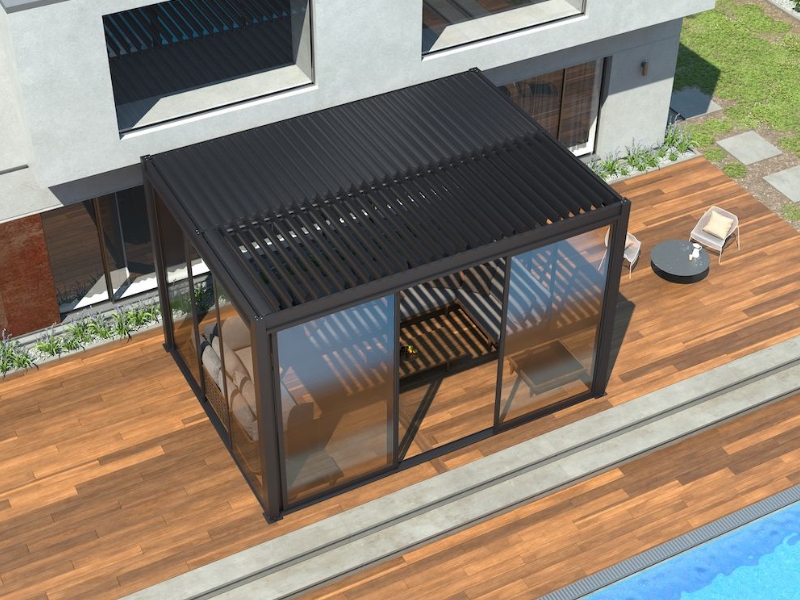A pergola is a fantastic addition to any outdoor space, offering the convenience of adjustable louvers for shade and protection at the touch of a button. But before you start envisioning your dream pergola system, particularly a motorised one, it’s important to consider whether your surface is suitable for installation. This article will walk you through the surfaces that can support a motorised pergola, the restrictions you may encounter, and how to handle less-than-ideal surfaces.
What surfaces are suitable for motorised pergola installation?
Motorised pergolas are versatile and can be installed on various surfaces as long as the base is stable and level. Here’s a handy table comparing the suitability of various surfaces for installing a motorised pergola:
Surface Type | Suitability for Motorised Pergola | Considerations | Best For |
Concrete | Excellent | Ensure it’s level and crack-free | Most reliable and long-lasting option |
Pavers | Good | Must be level and compacted | Outdoor areas with paving and stones |
Decking | Good | Must be structurally sound | Timber or composite deck installations |
Gravel | Fair | Needs to be compacted and stable | Low-cost options or rustic setups |
Tiles | Good | Ensure tiles are securely fixed | Modern homes with tiled outdoor areas |
As you can see, for a motorised pergola, concrete and tiles offer optimal surface installation. In contrast, gravel surfaces require additional attention to ensure stability.
Are there any restrictions for installing a motorised pergola?
While most surfaces can support a motorised pergola, there are a few restrictions and considerations to keep in mind:
- Uneven Ground: Surfaces that aren’t level can cause structural instability and make the pergola harder to operate.
- Loose Materials: Gravel or loosely laid pavers might cause the pergola to shift over time. Ensure you tightly pack and stabilise the materials.
- Weak Foundations: If the surface doesn’t have a solid, load-bearing foundation (such as unstable decking or poorly laid tiles), it might not be suitable for a motorised pergola.
- Restricted Space: Small or cluttered areas may not allow for proper installation or operation of the pergola.
- Local Regulations: In some areas, there are regulations regarding how close structures can be built to property boundaries or certain surfaces, particularly if you’re building near water. It’s essential to understand these local laws to ensure compliance. Learn about the building code requirements for structural steel to ensure your pergola is built with the right materials and meets safety standards.
Can you install a motorised pergola on sloped ground?
When it comes to surface installation, installing a motorised pergola on sloped ground can be tricky, but it’s not impossible. Here’s what you need to know.
- Levelling the Ground: If your land is uneven or sloped, you may need to level it out before installing the pergola. This can be done by filling in lower areas with soil or gravel to create a flat base.
- Adjustable Feet: Many pergola kits come with adjustable feet that can compensate for sloped ground, ensuring the structure remains stable and level. To maintain stability on uneven surfaces, it’s important to understand how deep the pergola footings need to be when installed on sloped ground. Deeper footings provide a stronger foundation, keeping your pergola secure over time.
- Retaining Walls: In some cases, building a retaining wall to level the ground might be necessary. This can provide a stable foundation for your pergola, especially if the slope is significant.
- Consider the Pergola’s Design: Some pergolas, particularly wall-mounted ones, are better suited to sloped ground than others. Consider the design and how it aligns with your specific terrain.
Proper preparation and smart design choices allow you to install a motorised pergola on sloped ground, enhancing your outdoor space with beauty and functionality.
What should you do if the surface isn’t ideal for installation?
If the surface you’re planning to install your motorised pergola on isn’t quite right, don’t worry. There are several solutions you can consider:
- Prepare the surface: If the surface is uneven, you may need to level it before installation. For gravel, compact it properly or add a level layer of sand or concrete for pavers to create a stable base.
- Reinforce the foundation: If your decking or tiles are not strong enough, reinforcing the foundation may be necessary. You might need additional support beams or braces beneath the surface.
- Install a concrete slab: For loose or weak surfaces, pouring a small concrete slab can provide a strong foundation to secure your pergola.
- Consult a professional: For those uncertain about their surface, a professional installer’s assessment is invaluable. They can review the location and recommend the most effective installation approach.
- Use additional supports: If your current surface is uneven or unstable, using anchors or supports can help secure the pergola and ensure it operates smoothly.
By addressing the surface issue and selecting the right pergola, you can enjoy a secure and functional outdoor addition. To achieve this lasting comfort and seamless integration, find the perfect motorised pergola to fit your specific outdoor needs, ensuring it blends seamlessly with your space and provides lasting comfort.
Conclusion
Choosing the right surface for your motorised pergola is key to ensuring a stable and long-lasting structure. Whether you’re working with a solid concrete base or need to make adjustments to your existing surface, there are solutions available. If you’re ready to enhance your outdoor space with a motorised pergola, consider Unique Pergolas for high-quality, easy-to-install DIY pergola kits. Our team is here to help with installation advice or services, ensuring your pergola stands strong for years to come!
If you’re keen to get started, get personalised advice for your pergola installation from Unique Pergolas.


